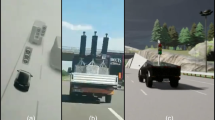Abstract
The supervisory controller for a robot cell is specified as a dynamic control policy that determines the part processing sequence and the robot work cycle depending on the state of the cell. The supervisory controller should be designed not only to satisfy the prescribed logical requirements or constraints, but also to achieve the maximum operating efficiency. We discuss modeling and control issues for robot task planning. We propose a two-phase approach to design the supervisory controller that consists of the logical design phase and the performance design phase. In the first phase, we use a model checking technique for concurrent automata to verify whether the proposed logical control rules satisfy the logical requirements. The logical control requirements may include deadlock prevention, obedience to the technological operation sequence of each part, or prevention of wasteful robot moves. In the second phase, we use semi-Markov decision models to determine additional control decisions for which the robot cell has the maximum throughput rate. We discuss the structure and algorithms of the performance control design problem.
Similar content being viewed by others
References
J. Browne and S. Wadhwa, Simulation: layout of a robot cell, in: Robot Technology and Application, U. Rembold, ed., Marcel Dekker, 1990.
E.M. Clarke, O. Grumberg and D.E. Long, Verification tools for finite-state concurrent systems, in: Proc. of a Decade of Concurrency: Reflections and Perspectives, Springer, 1994, pp. 124 - 175.
E.V. Denardo and B.L. Fox, Multichain Markov renewal programs, SIAM Journal of Applied Mathematics 16(1968)468 - 487.
M.P. Groover, M. Weiss, R.N. Nagel and N.G. Odrey, Industrial Robotics: Technology, Programming, and Applications, McGraw-Hill, 1986.
N.G. Hall, H. Kamoun and C. Sriskandarajah, Scheduling in robotic cells: Classification, two and three machine cells, Working Paper, College of Business, The Ohio State University, Columbus, Ohio, 1994.
Z. Har'El and R.P. Kurshan, Software for analytical development of communications protocols, AT&T Technical Journal 69(1990)45 - 59.
J.M. Jung, Design of supervisory control logic of a multi-robot assembly cell by automata-based model checking and Markov decision models, MS thesis, Department of Industrial Engineering, Korea Advanced Institute of Science and Technology, Taejon, Korea, 1997.
R. Kumar and V.K. Garg, Optimal supervisory control of discrete event dynamical systems, SIAM Journal of Control and Optimization 33(1995)419 - 439.
R.P. Kurshan, Automata-theoretic verification of coordinating processes, in: Lecture Notes in Control and Information Science 199: 11th International Conference on Analysis and Optimization of Systems: Discrete Event Systems, Sophia, 1994, G. Cohen and J.P. Quadrat, eds., Springer, 1994, pp. 16 - 28.
S.C. Liu and L. Lin, Dynamic sequencing of robot moves in a manufacturing cell, European Journal of Operational Research 69(1993)482- 497.
K.L. McMillan, The SMV system DRAFT, Working Paper, College of Computer Science, Carnegie Mellon University, PA, 1992.
K.L. McMillan, Symbolic Model Checking, Kluwer, 1993.
T. Murata, Petri nets: Properties, analysis and applications, Proc. of the IEEE 77 (1989)541 - 580.
M.L. Puterman, Markov Decision Process, Wiley, 1994.
P.J. Ramadge and W.M. Wonham, Modular feedback logic for discrete event systems, SIAM Journal of Control and Optimization 25(1987)1202 - 1218.
P.J. Ramadge and W.M. Wonham, Supervisory control of a class of discrete event processes, SIAM Journal of Control and Optimization 25(1987)206-230.
S.P. Sethi, C. Sriskandarajah, G. Sorger, J. Blazewicz and W. Kubiak, Sequencing of parts and robot moves in a robotic cell, International Journal of Flexible Manufacturing Systems 4(1992) 331 - 358.
B. Victor and F. Moller, The mobility workbench - a tool for the ?-calculus, in: Lecture Notes in Computer Science 818: Computer Aided Verification 6th International Conference, CVA' 94 Proceedings, Springer, 1994, pp. 428- 440.
N. Viswanadham, Y. Narahari and T.L. Johnson, Deadlock prevention and deadlock avoidance in flexible manufacturing systems using Petri net models, IEEE Transactions on Robotics and Automation 6(1990)713 - 723.
N. Viswanadham and Y. Narahari, Performance Modeling of Automated Manufacturing Systems, Prentice Hall, 1992.
H.M. Wang and H.P.B. Wang, Generation of optimal operating strategies for robotic cells: a Petri net approach, International Journal of CIM 8(1985)32- 42.
M. Zhou and F. DiCesare, Petri Net Synthesis for Discrete Event Control of Manufacturing Systems, Kluwer, 1993.
Rights and permissions
About this article
Cite this article
Lee, TE., Lee, JH. A two-phase approach for design of supervisory controllers for robot cells: Model checking and Markov decision models. Annals of Operations Research 77, 157–182 (1998). https://doi.org/10.1023/A:1018921310489
Issue Date:
DOI: https://doi.org/10.1023/A:1018921310489




